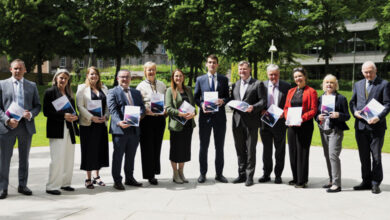Supporting the transformation of health services through digital

Jane Carolan, National Director of Health Business Services discusses transformation, shared business service models and innovation.
Outlining the creation of Health Business Services (HBS) in 2013 as the result of a government-led initiative to “organise and supply internal support services more efficiently and effectively whilst freeing up organisational capacity to concentrate on core, frontline and other health and social care functions”, Carolan says that the consolidation and streamlining of the business operations that are used by multiple parts of the organisation has presented huge opportunities of transformation, to the point where almost everything HBS do now has a digital component.
Carolan admits to any early-stage perception that digital transformation was something to be undertaken and led by IT specialists but adds: “We quickly learned that it was business owners themselves who have the best insight and knowledge about what their needs are in transforming their business, that they need to work in partnership with the Office of the Chief Information Officers and its IT specialists.”
The National Director states that recognition of the magnitude of change which would be achieved through collaboration with their ICT colleagues also informed the need for a clear strategy for their ambitions, where that fitted into the overall ambition of the Health Service Executive (HSE) and with what “Ireland Inc. was trying to do”.
Outlining the journey that HBS is on, Carolan highlights that their first strategy from 2014 to 2016 achieved 85 per cent implementation but adds: “The 15 per cent that we didn’t implement were all of the digital components. Amidst great progress in other areas, there was a challenge for us in implementing our digital transformation elements.”
The 2017 strategy, which runs to the end of this year incorporates projects and programmes in each of what Carolan describes as the SAMR ladder, an evolutionary map which starts at substitution (replacing something or someone with a digital solution, through augmentation (functional improvement on top of substitution), modification (significant task redesign) and redefinition (the creation of new tasks previously inconceivable).
“All of these interventions are necessary as we look across our digital journey in HBS we have programmes and projects which fall into each of these categories. What’s really important to us is staying open to the small, as well as the big, digital opportunities.”
Carolan details progress in six areas where major transformation is ongoing. The first is around robotics, with the National Director stating that rather than being the future, robotics is very much a current tool being used by HBS.
“We currently have several proof of concept projects underway working in partnership with the Department of Public Expenditure and Reform. For our kind of business, robotics is a no brainer but our focus most be on how we land these projects, where we land them and what we utilise them for.”
Three pilots carried out by HBS in robotic process automation processes in 2018, including in the areas of finance (hospital income debtors collation and reporting), HR (leaving process) and HR (Garda vetting consent logging) have brought about a combined efficiency saving of 720 hours of working time equivalent per month.
“The results are exciting,” says Carolan. “We see real opportunities through the introduction of robotics to facilitate our staff to bring more added value and to deliver better output.”
The second area surrounds customer relationship management (CRM) and a move to ensure continued excellence in business relationship management. Carolan says that bringing this intelligence into HBS ensures that they are not making repeat mistakes and are fully aware of customer needs and demands.
Talking about the six areas in general she adds: “None of these implementations are simple. They are multi-year implementations, most of them with targeted full implementation of five years.”
What’s really important to us is staying open to the small, as well as the big, digital opportunities.
One of those multi-year implementations will be the introduction of a National Integrated Staff Records and Payroll service to enable a single source of truth for staff records and allow a self service portal for staff to access information. The scheme will take learning and technology from the failed Personnel, Payroll and Related Systems (PPARS), originally commissioned in 1999 but suspended amidst findings of poor performance and manageability. Discussing the challenge of “fast-forwarding” the current system, Carolan says: “The journey we are embarking on is estimated to take around five years and is following on from a decade of neglect of back office systems within the health service. We are starting from a low base.”
Another long-term project is that of HBS Estates, a major digital transformation which will enable a single source of truth for over 6,000 sites/buildings, management, maintenance, construction and medical equipment. HBS are in the process of issuing a tender for a national estates information system following on from what Carolan describes as core work of assessing and taking learning from international best practice before implementing a plan on a “green field” area.
An area of transformation that is well underway is the digitisation of HBS’s national distribution centre in Tullamore. The centre, which predates the creation of HBS, has been expanded and continues to improve on digital opportunities. The digital distribution system is 70 per cent implemented across the country and has brought about a saving of at least €6.3 million in clinical nurse time and demand reduction, a figure which Carolan highlights is a conservative estimate. HBS are currently planning for a further hub in Dublin to drive further efficiencies.
Lastly, Carolan highlights the creation of an Integrated Financial Management System (IFMS) which aims to upgrade and join financial systems nationally for a centralised view of financial data, allowing reports. She adds: “The HBS are custodians of a huge volume of data to the point where we currently don’t have the capacity to mine it all, use it and inject it back into the system. How we best do this will be a challenge for us going forward.”
Concluding, Carolan says that while digital technology may be a facilitator of service transformation, it is not the sole driver, instead she points to a large role for the process side of transformation and an even bigger role for culture an organisational change.
“We started off by looking at our ICT colleagues to tell us what transformation to have and where to have it but we’ve been on a journey and we now have a better understanding of digital’s potential and how we can drive it internally. Culture has always been an important element for us and from HBS’s creation we have sought to mobilise our 1,500 staff in innovation and to equip them with the knowledge that what they are doing is having an impact on wider health services.”





